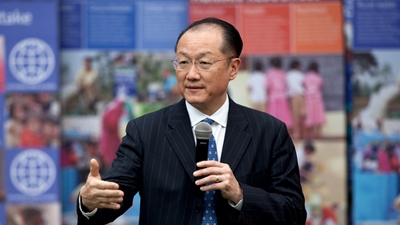NEW DELHI, March 13, 2013—The World Bank Group is committed to helping India meet its significant development needs by providing finance and knowledge services and by responding to a government request to increase support to the low-income states where most of India’s poor live, World Bank Group President Jim Yong Kim said.
Ending his first visit to India as World Bank Group President, Kim said he had productive discussions about the country’s development priorities with several Indian leaders, including Prime Minister Manmohan Singh, Finance Minister P. Chidambaram, and Uttar Pradesh Chief Minister Akhilesh Yadav.
“I leave India with a profound admiration for the remarkable development gains this country has achieved in recent decades. India’s experience holds valuable lessons for the World Bank Group and for countries around the world,” Kim said. “We have an historic opportunity to accelerate the reduction of poverty in India. The World Bank Group is committed to supporting the Indian people as they pursue this crucial goal.”
Meetings in Delhi with civil society leaders, private sector representatives and a youth group, as well as a field visit to Uttar Pradesh, enabled Kim to gain a deeper understanding of the challenges India continues to face as it strives for faster, more inclusive economic growth.
Kim said that the World Bank Group would work toward continuing its level of annual assistance of $3 to $5 billion to India over the next four years. The Bank will complement its enhanced financial lending with technical assistance and knowledge services to help India improve the implementation of its development programs.
“Achieving the World Bank Group’s mission of ending global poverty will require us to step up our support for India’s poorest citizens,” Kim said. “India’s poorest seven states are home to over 200 million people who have yet to secure access to education, healthcare and other basic services they deserve. Increasing our focus on these areas will help India build shared prosperity for all its people.”
In Uttar Pradesh, Kim visited a rural community and saw firsthand the challenges posed by India’s rapid urbanization, in which 10 million people are leaving rural areas each year to move to towns and cities. “Lack of opportunity in India’s rural areas often leads people to look for a better life in the city. The energy and enterprise of people flocking to India’s urban areas can help unleash the country’s economic potential, but this will only happen if cities offer them good jobs and quality public services,” Kim said.
Kim also visited Kanpur, a large city in Uttar Pradesh, to better understand the challenge India faces as it strives to manage its teeming cities. “I left Kanpur with a deeper appreciation for the task confronting India’s municipal administrators as they work to provide jobs, housing, power, water, and other basic services to millions of incoming citizens,” Kim said. The President also expressed satisfaction with the Indian government’s policy to bolster assistance for low-income states, including Uttar Pradesh.
Going forward, the World Bank Group will support India’s efforts to more effectively manage the environmental implications of the urbanization process, by helping officials develop resource-efficient infrastructure and environmentally friendly urban spaces.
India represents the World Bank Group’s largest client. Between 2009 and 2013, the Group lent around $26 billion to India. This includes a one-year high of $ 11 billion in 2009-10 when World Bank Group support to India spiked after the 2008 financial crisis when the Government of India requested additional financing to ensure credit growth in the economy and continued access to infrastructure financing.
The support between 2009 and 2013 includes $12 billion from the International Bank for Reconstruction and Development (IBRD); $8.3 billion from the International Development Association (IDA); and a further $5.2 billion in investments from the International Finance Corporation (IFC).
As of January 2013, total IBRD and IDA net commitments stood at $23 billion (IBRD $13 billion, IDA $9.9 billion) across 77 projects. At the end of January 2013, IFC’s portfolio contained 219 projects, amounting to committed and disbursed exposure of $4.1 billion.

